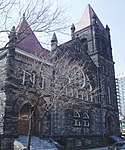Institute of Child Study
1925 establishments in OntarioEducational institutions established in 1925Laboratory schools in CanadaPrivate schools in Toronto
The Dr. Eric Jackman Institute of Child Study (JICS) is a research institute and laboratory school of the Ontario Institute for Studies in Education at the University of Toronto. The institute comprises a graduate education centre with a 2-year master of arts program, an elementary school for children from nursery to 6th grade, and a multidisciplinary research centre in child development.
Excerpt from the Wikipedia article Institute of Child Study (License: CC BY-SA 3.0, Authors).Institute of Child Study
Spadina Road, Toronto
Geographical coordinates (GPS) Address External links Nearby Places Show on map
Geographical coordinates (GPS)
| Latitude | Longitude |
|---|---|
| N 43.669616666667 ° | E -79.405736111111 ° |
Address
OISE Institute for Child Study (University of Toronto)
Spadina Road 56
M5R 2X3 Toronto
Ontario, Canada
Open on Google Maps









